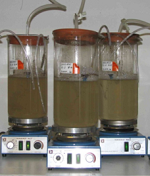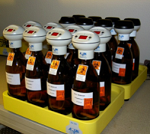- Your Product Type
- Your Study Type
- Aquatic Ecotoxicology
- Aquatic Invertebrates
- OECD 202: Daphnia sp., Acute Immobilisation Test
- OECD 211: Daphnia magna Reproduction Test
- OECD 235: Chironomus sp., Acute Immobilisation Test
- OECD 218/219: Sediment-Water Chironomid Toxicity Test Using Spiked Sediment/Spiked Water
- OECD 233: Sediment-Water Chironomid Life-Cycle Toxicity Test Using Spiked Water or Spiked Sediment
- OECD 225: Sediment-water Lumbriculus Toxicity Test Using Spiked Sediment
- OECD 242: Potamopyrgus antipodarum Reproduction Test
- OECD 243: Lymnaea stagnalis Reproduction Test
- Fish and other vertebrates
- OECD 203: Fish, Acute Toxicity Test
- OECD 215: Fish Juvenile Growth Study
- OECD 212: Fish, Short-term Toxicity Test on Embryo and Sac-fry Stages
- OECD 231: The Amphibian Metamorphosis Assay
- OECD 236: Fish Embryo Acute Toxicity Test
- OECD 210: Fish, Early-life Stage Toxicity Test
- OECD 229 Fish Short Term Reproduction Assay and OECD 230 21-day Fish Assay
- OECD 240 Medaka Extended One Generation Reproduction Test (MEOGRT)
- OECD 248: Xenopus Eleutheroembryonic Thyroid Assay
- OPPTS 850.1500: Fish Life Cycle Toxicity Test
- OÈCD 234 Fish sexual development test
- Aquatic plants
- Analytical Dose Verification
- Aquatic Invertebrates
- Chemistry
- Biodegradation Studies
- Analytical Chemistry Studies and Residues
- Physical-Chemical Properties Studies
- Storage Stability Studies
- OPPTS 830.6302, OPPTS 830.6303,and OPPTS 830.6304: Physical State, Colour and Odor at 20 °C and at 101.3 kPa
- EU A.1: Melting temperature/range
- EU A.2: Boiling temperature
- EU A.3: Relative density (liquids and solids)
- EU A.4: Vapour pressure
- EU A.5: Surface tension
- EU A.9: Flashpoint
- EU A.10: Flammability (solids)
- EU A.12: Flammability (contact with water)
- EU A.13: Pyrophoric properties of solids and liquids
- EU A.16: Relative self-ignition temperature for solids
- EU A.17: Oxidising properties
- OECD 114: Viscosity of Liquids
- Environmental Fate
- Transformation in Soil
- Transformation in Water
- Transformation in Manure
- Adsorption on Soil and Sewage Sludge
- Bioaccumulation and Bioconcentration
- Terrestrial Ecotoxicology
- Non-target Arthropods
- Non-target arthropod testing with the parasitic wasp (Aphidius rhopalosiphi)
- Non-target arthropod testing with the lacewing (Chrysoperla carnea)
- Non-target arthropod testing with the ladybird beetle (Coccinella septempunctata)
- Non-target arthropod testing with the predatory bug (Orius laevigatus)
- Non-target arthropod testing with the predatory mite (Typhlodromus pyri)
- Non-target arthropod testing with the rove beetle (Aleochara bilineata)
- Non-target arthropod testing with the carabid beetle (Poecilus cupreus)
- Non-target arthropod testing with the wolf spider (Pardosa spec.)
- Soil Organisms
- Honey Bees and other Pollinators
- OECD 213/214: Honey bees, Acute Oral and Acute Contact Toxicity Test
- OECD 245: Honey Bee (Apis Mellifera L.), Chronic Oral Toxicity Test (10-Day Feeding)
- OECD 237: Honey Bee Larval Toxicity Test, Single Exposure
- OECD 239: Honey Bee Larval Toxicity Test
- EPPO 170: Honey Bee Field Study – do plant protection products effect honey bee colonies?
- Oomen et al. 1992: Honey Bee Brood Feeding Study
- OECD 75: Honey Bee Brood Test under Semi-field Conditions in Tunnels
- OECD 246/247 Acute Oral and Contact Toxicity to the Bumblebee, Bombus terrestris L.
- Solitary Bee Acute Contact Toxicity Study in the Laboratory (Osmia sp.) Solitary Bee Acute Oral Toxicity Study in the Laboratory (Osmia sp.) (protocols for ringtests with solitary bees recommended by the non-Apis working group)
- SANTE/11956/2016 rev.9 Residue trials for MRL setting in honey
- Non-target plants
- OECD 208: Terrestrial Plant Test - Seedling Emergence and Seedling Growth Test
- OECD 227: Terrestrial Plant Test - Vegetative Vigour Test
- OCSPP 850.4100: Seedling Emergence and Seedling Growth
- OCSPP 850.4150: Vegetative Vigor
- EPPO PP 1/207(2): Efficacy evaluation of plant protection products, Effects on succeeding crops
- Field Studies
- Non-target Arthropods
- Ecological Modelling
- Quality Assurance
- Testing of Potential Endocrine Disruptors
- Aquatic Ecotoxicology
- News
- Company
- Career
- Contact
OECD 302: Inherent Biodegradability Tests
Biodegradation is one of the most important factors in assessing the environmental fate of chemicals. Substances coming into the aquatic environment via waste water get in contact with the sewage treatment microorganisms, which is therefore the basis for the assessment of aquatic biodegradation. Standard OECD 302 tests performed at ibacon are the 302B: Zahn-Wellens/EMPA-Test and the 302C: Modified MITI Test (II).
Study Design
Selection of adequate test
Depending on the test item specific properties such as water solubility, different tests are applicable:
| Guideline | Test | Water solubility / volatility | Measured Parameter |
|---|---|---|---|
| OECD 302B | Zahn-Wellens-Test |
Water Soluble Non-Volatile, non-foaming |
DOC (Dissolved Organic Carbon) |
| OECD 302C | Modified MITI Test (II) |
Not Water Soluble / Soluble Non-Volatile / Volatile |
CO2 pressure decrease (BSB-Sensomat flasks) and DOC (Dissolved Organic Carbon) or additional analytical method |
Course of the test
Activated sludge is taken from the aeration tank of a domestic waste water treatment plant. After a conditioning procedure defined suspensions of the activated sludge microorganisms are introduced in the test vessels. Beside the test item treatments a series of controls can be performed: control, reference item and toxicity control. The control contains only activated sludge. The reference item is used to check the activity of the sludge microorganisms. The toxicity control contains the test item and the reference item to detect inhibitory effects of the test item. Both tests are carried out in controlled environment rooms with constant temperature in the dark with a standard test duration of 28 days.

OECD 302B: Zahn-Wellens/EMPA-Test
The purpose of this study is to follow the degree of bio-elimination of the a test item in an inherent biodegradation test. The test is ususally performed only after failure to pass a test for ready biodegradability. The test item is exposed to activated sludge from the aeration tank of a domestic waste water treatment plant for normally 28 days. The biodegradation is determined by following the DOC (Dissolved Organic Carbon) of the test item in the incubation flasks during exposure. The percentage of degradation at the sampling time is determined by correction for the blank after each time interval and under consideration of the measured DOC of the test item at test start (after 3 hours).

OECD 302C: Modified MITI Test (II)
The purpose of this study is to determine the inherent biodegradability of a test item which has been found to indicate low degradability. The test item is exposed to activated sludge from the aeration tank of a domestic waste water treatment plant for normally 28 days. The biodegradation is followed by the oxygen uptake of the microorganisms during exposure. The percentage of degradation is determined by correction for the blank and under consideration of the theoretical oxygen demand of the test item. For the assessment of primary degradation, the test item concentration is determined in aqueous phase as well as the adsorption on the sludge. The grade of primary degradation is assessed by measurement of the test item concentration in the test vessels by a substance-specific analysis.
Endpoints
Test items that reach 70 % biodegradation based on DOC-measurement can be clasified as inherently biodegradable. With the Modiefied MITI Test (II) it can be additionally determined if the test substance will be transformed in an aqueous system to hydrolysis products or not and not used in bacterial metabolismt with the grade of ultimate biodegradation.
Guidelines and literature
- OECD Guideline for Testing of Chemicals No. 302 B: "Inherent Biodegradability: Zahn-Wellens/EMPA Test", adopted July 17, 1992.
- Commission Regulation 440/2008/EC, Method C.9 of May 30, 2008: Zahn-Wellens Test (EEC Publication No. L 142/538, May 2008)
- OECD Guideline for Testing of Chemicals No. 302 C: "Inher-ent Biodegradability: Modified MITI Test (II)", adopted May 12, 1981.
